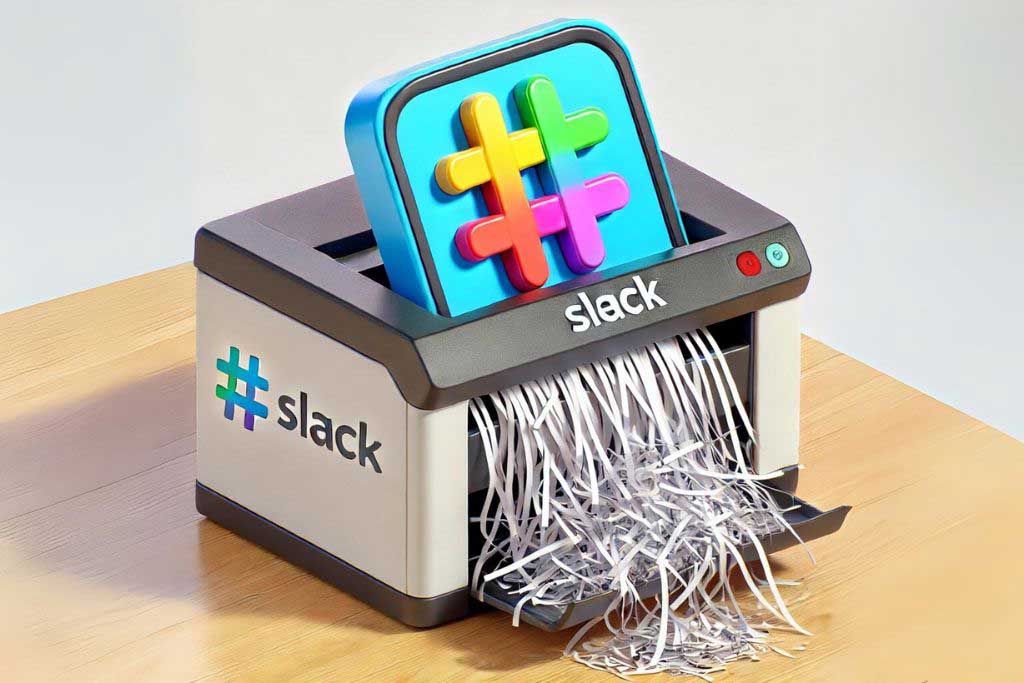San Francisco, CA – June 28, 2024 – In a significant shift for users of its free tier, Slack has announced that it will start automatically deleting messages and files older than one year. This new policy, aimed at managing data storage and improving platform performance, will take effect from August 26, 2024 according to the communication platform. Read on to see how this update will affect your company, workspace owners, team members and when Slack will delete your messages.
The popular workplace communication tool, which has become indispensable for millions of users worldwide, revealed this update in a blog post and updated its terms of service. Slack’s free plan currently allows access to the most recent 90 days of message history and files. The new retention policy will extend this to a rolling 12-month period, but any Slack messages beyond that will be deleted. According to the company website, “It will not be possible to restore messages and files once deletion occurs.”
Rationale Behind the Change
Slack’s decision stems from the increasing amount of data stored on their servers due to the platform’s growing user base. The company noted that maintaining vast amounts of data for free accounts has become unsustainable. By implementing this new policy, Slack aims to ensure a smoother user experience and more efficient service delivery.
“By limiting the storage of old messages and files, we can allocate resources more effectively and continue to provide a high-quality experience for all users,” said Ilan Frank, Vice President of Product at Slack. “This change allows us to maintain the speed and reliability our users expect while also managing the costs associated with data storage.”
Impact on Slack Admins & Users
The announcement has elicited mixed reactions from Slack’s free-tier users. While some appreciate the platform’s need to manage resources and ensure efficiency, others are concerned about losing valuable historical data. Org owners now need to consider whether or not to upgrade to paid plans for the entire team, or implement best practices of message management, and choose which specific content needs to be retained in perpetuity. One of the better things that most users love, leading to Slack’s rise in popularity, is its freemium pricing model. That model just got more complicated, leaving workspace admins scrambling to find potential avenues for public channels and private messages before Slack starts to delete messages.
Small business owners who rely on Slack for team communication are rightly concerned. Any important project discussions and files that are over a year old are now in question, and losing that information could be problematic.
One user posted Slack and Google data retention grievances on X:
In other news, @Slack will also start deleting all your data by August 26, 2024 if you’re on a free plan
They’ll delete anything over 12 months old
That’s 10+ years of tens of thousands of Slack community chats, photos and files history lost forever
It’s really sad, and it’s… https://t.co/aP1Kfrq2S5 pic.twitter.com/Vq3Flgc4eJ
— @levelsio (@levelsio) June 27, 2024
In response to such concerns, Slack has recommended that users who need to retain older messages and files consider upgrading to one of their paid plans, which offer extended and customizable retention policies in the digital workspace.
Options for Retaining Data
Slack has outlined various methods users can take to prepare for this change:
- Export Data: Users can export their conversation history and files before the August 26 deadline. This option is the best way for those who need to keep historical data for record-keeping or legal purposes.
- Upgrade to a Paid Plan: Upgrading to a paid plan allows users to access advanced features for deletion options, including customizable message and file retention policies.
- Use Third-Party Backup Services: Several third-party services offer backup solutions specifically designed for Slack. These services can help users preserve their data beyond the 12-month limit.
Looking Forward
While the policy change may pose challenges for some users, Slack remains committed to its mission of making workplace communication more efficient and effective. By managing data more judiciously, the platform aims to continue delivering top-notch service to its millions of users.
For more information on how to export data or upgrade plans, users and org admins can visit Slack’s help center or contact their support team.
About Slack
Slack is a leading collaboration hub that connects work teams with the people, information, and tools they need to get work done. Founded in 2013 and headquartered in San Francisco, California, Slack has played a crucial role in workplace communication and is used by millions of people around the world. The platform offers various plans to cater to different organizational needs, from small businesses to large enterprises.
Slack’s story begins in 2009 with the founding of Tiny Speck, a company led by Stewart Butterfield, who had previously co-founded the photo-sharing site Flickr. Tiny Speck was developing an online game called Glitch, which, despite its creative and ambitious nature, struggled to find a substantial user base. During the development of Glitch, the team created an internal communication tool to streamline their workflows and improve collaboration.
By 2012, it was clear that Glitch wasn’t going to succeed. Tiny Speck decided to shut down the game, but the team recognized the potential of their internal communication tool. They pivoted, refocusing their efforts on refining and commercializing this tool. In August 2013, Slack (an acronym for “Searchable Log of All Conversation and Knowledge”) was officially launched.
Early Growth and Adoption
Slack’s early success can be attributed to its intuitive design, robust feature set, and the rising demand for better workplace communication solutions. Unlike traditional email, Slack offered real-time messaging, organized channels, searchable archives, and integrations with other select tools. This combination proved to be a game-changer.
Within six months of its launch, Slack had over 15,000 daily active users. Its popularity soared as word spread about its ability to enhance team productivity and streamline communication. By 2014, Slack had secured $42.75 million in funding, underscoring investor confidence in its potential.
Key Features and Innovations
Several features helped distinguish Slack from other communication tools:
- Channels: Organized spaces for team discussions, project updates, and general chit-chat, reducing email clutter.
- Searchability: Every message and file was easily searchable, making it simple to retrieve past conversations and documents.
- Integrations: Slack integrated seamlessly with other business tools such as Google Drive, Trello, and GitHub, providing a central hub for work.
- Customizability: Users could tailor notifications, create custom emojis, and personalize their Slack experience.
These features, combined with a user-friendly interface, made Slack indispensable for teams of all sizes.
Expansion and Market Dominance
As Slack’s user base grew, so did its feature set and integrations. The platform continually evolved, introducing new functionalities like voice and video calls, workflow automation, and enhanced security measures. By 2017, Slack had over 6 million daily active users, including many Fortune 500 companies.
In 2019, Slack went public, trading on the New York Stock Exchange under the ticker symbol “WORK.” The company’s valuation soared, reflecting its status as a critical tool for modern businesses.
Adapting to a Changing Workplace
The COVID-19 pandemic in 2020 further accelerated Slack’s growth. With millions of employees transitioning to remote work, the demand for effective virtual collaboration tools skyrocketed. Slack rose to the occasion, offering free trials, enhancing features, and ensuring robust support for its users.
In December 2020, Salesforce announced its acquisition of Slack for $27.7 billion, marking one of the largest tech acquisitions in history. The deal closed in July 2021, with Slack becoming an integral part of Salesforce’s ecosystem, further expanding its reach and capabilities.
Current Status and Future Prospects
Today, Slack boasts over 12 million daily active users and continues to be a leader in workplace communication. The platform is constantly innovating, with recent additions like Slack Connect, which allows secure communication between organizations, and advanced AI-driven features to improve user experience.
Slack’s success story is a testament to the power of adaptability, user-centric design, and relentless innovation. From a failed game to a multi-billion-dollar enterprise tool, Slack has indeed revolutionized the way the world works.
As businesses continue to evolve in a post-pandemic world, Slack’s role in facilitating seamless communication and collaboration remains more critical than ever. With its ongoing commitment to innovation and integration within Salesforce, Slack is poised to remain at the forefront of workplace technology for years to come.
Stay tuned to Slack’s official blog and social media channels for further updates regarding deleted messages.
Related: The Problem With Slack


